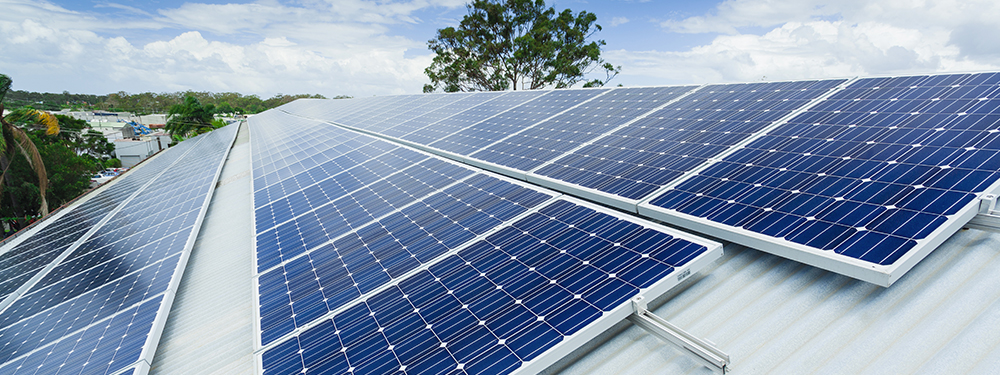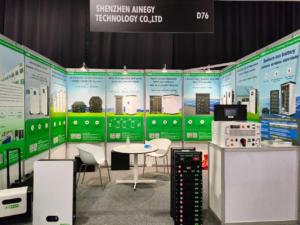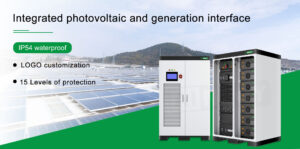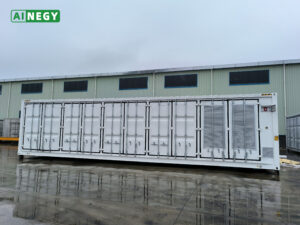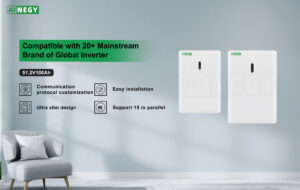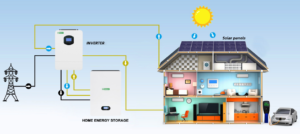Sometimes two is better than one. Coupling solar energy and storage technologies is one such case. The reason: Solar energy is not always produced at the time energy is needed most. Peak power usage often occurs on summer afternoons and evenings, when solar energy generation is falling. Temperatures can be hottest during these times, and people who work daytime hours get home and begin using electricity to cool their homes, cook, and run appliances.
Storage helps solar contribute to the electricity supply even when the sun isn’t shining. It can also help smooth out variations in how solar energy flows on the grid. These variations are attributable to changes in the amount of sunlight that shines onto photovoltaic (PV) panels or concentrating solar-thermal power (CSP) systems. Solar energy production can be affected by season, time of day, clouds, dust, haze, or obstructions like shadows, rain, snow, and dirt. Sometimes energy storage is co-located with, or placed next to, a solar energy system, and sometimes the storage system stands alone, but in either configuration, it can help more effectively integrate solar into the energy landscape.
What Is Energy Storage?
“Storage” refers to technologies that can capture electricity, store it as another form of energy (chemical, thermal, mechanical), and then release it for use when it is needed. Lithium-ion batteries are one such technology. Although using energy storage is never 100% efficient—some energy is always lost in converting energy and retrieving it—storage allows the flexible use of energy at different times from when it was generated. So, storage can increase system efficiency and resilience, and it can improve power quality by matching supply and demand.
Storage facilities differ in both energy capacity, which is the total amount of energy that can be stored (usually in kilowatt-hours or megawatt-hours), and power capacity, which is the amount of energy that can be released at a given time (usually in kilowatts or megawatts). Different energy and power capacities of storage can be used to manage different tasks. Short-term storage that lasts just a few minutes will ensure a solar plant operates smoothly during output fluctuations due to passing clouds, while longer-term storage can help provide supply over days or weeks when solar energy production is low or during a major weather event, for example.
Advantages of Combining Storage and Solar
- Balancing electricity loads – Without storage, electricity must be generated and consumed at the same time, which may mean that grid operators take some generation offline, or “curtail” it, to avoid over-generation and grid reliability issues. Conversely, there may be other times, after sunset or on cloudy days, when there is little solar production but plenty of demand for power. Enter storage, which can be filled or charged when generation is high and power consumption is low, then dispensed when the load or demand is high. When some of the electricity produced by the sun is put into storage, that electricity can be used whenever grid operators need it, including after the sun has set. In this way, storage acts as an insurance policy for sunshine.
- “Firming” solar generation – Short-term storage can ensure that quick changes in generation don’t greatly affect the output of a solar power plant. For example, a small battery can be used to ride through a brief generation disruption from a passing cloud, helping the grid maintain a “firm” electrical supply that is reliable and consistent.
- Providing resilience – Solar and storage can provide backup power during an electrical disruption. They can keep critical facilities operating to ensure continuous essential services, like communications. Solar and storage can also be used for microgrids and smaller-scale applications, like mobile or portable power units.
Types of Energy Storage
The most common type of energy storage in the power grid is pumped hydropower. But the storage technologies most frequently coupled with solar power plants are electrochemical storage (batteries) with PV plants and thermal storage (fluids) with CSP plants. Other types of storage, such as compressed air storage and flywheels, may have different characteristics, such as very fast discharge or very large capacity, that make them attractive to grid operators. More information on other types of storage is below.
Pumped-Storage Hydropower
Pumped-storage hydropower is an energy storage technology based on water. Electrical energy is used to pump water uphill into a reservoir when energy demand is low. Later, the water can be allowed to flow back downhill and turn a turbine to generate electricity when demand is high. Pumped hydro is a well-tested and mature storage technology that has been used in the United States since 1929. However, it requires suitable landscapes and reservoirs, which may be natural lakes or man-made by constructing dams, requiring lengthy regulatory permits, long implementation times, and large initial capital. Other than energy arbitrage, pumped hydro’s value of services to integrate variable renewables are not fully realized, which can make the financial payback period long. These are some of the reasons pumped hydro has not been built recently, even though interest is evident from requests to the Federal Energy Regulatory Commission for preliminary permits and licenses.
Electrochemical Storage
Many of us are familiar with electrochemical batteries, like those found in laptops and mobile phones. When electricity is fed into a battery, it causes a chemical reaction, and energy is stored. When a battery is discharged, that chemical reaction is reversed, which creates voltage between two electrical contacts, causing current to flow out of the battery. The most common chemistry for battery cells is lithium-ion battery, but other common options include lead-acid, sodium, and nickel-based batteries.
Thermal Energy Storage
Thermal energy storage is a family of technologies in which a fluid, such as water or molten salt, or other material is used to store heat. This thermal storage material is then stored in an insulated tank until the energy is needed. The energy may be used directly for heating and cooling, or it can be used to generate electricity. In thermal energy storage systems intended for electricity, the heat is used to boil water. The resulting steam drives a turbine and produces electrical power using the same equipment that is used in conventional electricity generating stations. Thermal energy storage is useful in CSP plants, which focus sunlight onto a receiver to heat a working fluid. Supercritical carbon dioxide is being explored as a working fluid that could take advantage of higher temperatures and reduce the size of generating plants.
Flywheel Storage
A flywheel is a heavy wheel attached to a rotating shaft. Expending energy can make the wheel turn faster. This energy can be extracted by attaching the wheel to an electrical generator, which uses electromagnetism to slow the wheel down and produce electricity. Although flywheels can quickly provide power, they can’t store a lot of energy.
Compressed Air Storage
Compressed air storage systems consist of large vessels, like tanks, or natural formations, like caves. A compressor system pumps the vessels full of pressurized air. Then the air can be released and used to drive a turbine that produces electricity. Existing compressed air energy storage systems often use the released air as part of a natural gas power cycle to produce electricity.
Solar Fuels
Solar power can be used to create new fuels that can be combusted (burned) or consumed to provide energy, effectively storing the solar energy in the chemical bonds. Among the possible fuels researchers are examining are hydrogen, produced by separating it from the oxygen in water, and methane, produced by combining hydrogen and carbon dioxide. Methane is the main component of natural gas, which is commonly used to produce electricity or heat homes.
Virtual Storage
Energy can also be stored by changing how we use the devices we already have. For example, by heating or cooling a building before an anticipated peak of electrical demand, the building can “store” that thermal energy so it doesn’t need to consume electricity later in the day. The building itself is acting as a thermos by storing cool or warm air. A similar process can be applied to water heaters to spread demand out over the day.
Ultimately, residential and commercial solar customers, and utilities and large-scale solar operators alike, can benefit from solar-plus-storage systems. As research continues and the costs of solar energy and storage come down, solar and storage solutions will become more accessible to all Americans.
